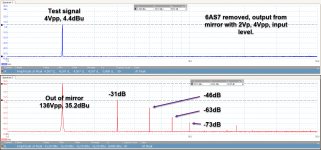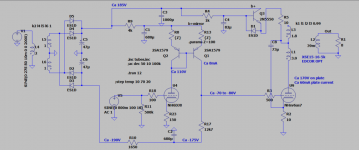The tube sound is generally about how the final output distorts the true sound.
I agree with this, the classic - and archaic - discussion of "tube pre and SS power" or vice versa, does not make sense. The resulting sound will be that of the final link in the chain.
As most line amplification is constrained to the linear operation of the devices used I can't see a tube buffer adding the real tube sound to the signal.
I built tube and solid state amps a long time ago. The differences in sound were obvious (in favor of the tube) but modern tube amps no longer have that "tube sound" we were used to, and SS amps have evolved a lot since the days of the first "quasi-complementary ABs". ".
In fact, current (and prestigious) SS vs. Tube amps sound too similar for anyone who doesn't have very trained ears to recognize the differences. SS amps for HT and online tube kits that emulate famous old amps are excluded from this comparison.
There you can easily hear the old school "valve sound". Let's call it 2nd harmonic distortion or whatever.
In good original tube equipment, part of the reasons for its sound is due to things never really discussed, nor understood by many.
The topics are about a plethora of "distortions", yet I can't remember one discussing the hysteresis effects in output transformers, which cannot be changed, and which give "the tube sound" its signature.
The topics are about a plethora of "distortions", yet I can't remember one discussing the hysteresis effects in output transformers, which cannot be changed, and which give "the tube sound" its signature.
So, referring to post # 109 the recipe is to add 1% 2nd harmonic, 0.3% 3rd harmonic and you get tube sound. 😕
There’s really no such thing as tube sound. Different tube amps distort differently. My 300B amp is SE, and produces primarily 2nd order harmonics. But my PP EL34 amps do not sound significantly different from SS amps for the most part. Then tube amps do not produce square waves when they clip. They still look more like sine waves, and often asymmetrical, which probably contributes to some of the so-called tube sound.
But I would think that the 2nd harmonic and some 3rd harmonic distortion products contribute to most of the signatures that are referred to as tube sound.
My current main amp is my reserve (kitchen) flea power 6AS7 SE at max 2W output. It has huge amounts of 2nd. Probably -30dB at less than 1W and -20dB at just above 1W. Thats ca 10% 2nd! The higher harmonics are low.
The reason for the huge amounts of 2nd is my current mirrored 6922 prviding the gain and drive. The mirror prduces same phase output so both tubes are driven positive and negative in phase. This does not give the usual cancellation we get when they are not in phase.
This amp sounds so sweet. Yesterday I noticed my teen daughter sitting on the floor between the speakers, eyes closed listening to music. She has asked me before the why she does not listen so much to music at her moms. At their home the stereo is out of sight as in most womens homes.
So there definately is something to the 2nd harmonic. Btw the sound is clear and punchy. I cannot directly hear the 2nd. Just the silkyness in the sound.
Edit: darnit. I just said I do hear it in 'the silkyness in the sound'. Well I am just trying to describe it sounds great. I actually cant hear anything is done to the sound. I contribute the silkyness more to the classA operation than the 2nd harmonic. Anyways. I dont believe anyone listening to the sound will go: oh yeah thats the 2nd I hear right there!'
The reason for the huge amounts of 2nd is my current mirrored 6922 prviding the gain and drive. The mirror prduces same phase output so both tubes are driven positive and negative in phase. This does not give the usual cancellation we get when they are not in phase.
This amp sounds so sweet. Yesterday I noticed my teen daughter sitting on the floor between the speakers, eyes closed listening to music. She has asked me before the why she does not listen so much to music at her moms. At their home the stereo is out of sight as in most womens homes.
So there definately is something to the 2nd harmonic. Btw the sound is clear and punchy. I cannot directly hear the 2nd. Just the silkyness in the sound.
Edit: darnit. I just said I do hear it in 'the silkyness in the sound'. Well I am just trying to describe it sounds great. I actually cant hear anything is done to the sound. I contribute the silkyness more to the classA operation than the 2nd harmonic. Anyways. I dont believe anyone listening to the sound will go: oh yeah thats the 2nd I hear right there!'
Last edited:
Lot's of IMD too.
Well here are FFTs of 0.25W and at almost clip 2W. Also include the output of the driver/gain stage, having removed the 6AS7.
Not so much IMD here, but with music I'm sure you are right.
Note that at 2W, the THD out of the driver is only a bit lower on the 2nd, the higher harmonics are created in the driver, not so much the 6AS7, because out of the 6AS7 the higher than 2nd are not any higher than what is feeding it's grids.
Attachments
Last edited:
Perhaps include the schematic:
(Edit: Btw the transistor models are just picked out of LTs lib, I am too lazy to insert the actual transistors. Nothing special about them, but the LT models are not rated to the high violtages. Luckily they still work for simulations, and it gets close enough to real life measurements)
*Except the LTspice FFT is NOT accurate. As many people mention in tons of threads, LTspice is great, but the FFTs are WRONG. They do perhaps give a relative indications between two different circuit tweeks, but not as they will really be in real life.
(Edit: Btw the transistor models are just picked out of LTs lib, I am too lazy to insert the actual transistors. Nothing special about them, but the LT models are not rated to the high violtages. Luckily they still work for simulations, and it gets close enough to real life measurements)
*Except the LTspice FFT is NOT accurate. As many people mention in tons of threads, LTspice is great, but the FFTs are WRONG. They do perhaps give a relative indications between two different circuit tweeks, but not as they will really be in real life.
Attachments
Last edited:
The problem is, you can't have harmonic distortion without intermodulation distortion, which isn't pleasing.
As you can't have HD without IMD it makes you conclusion a red herring since many people find tube amp sound pleasing.
As you can't have HD without IMD it makes you conclusion a red herring since many people find tube amp sound pleasing.
I think Scott has a point in many designs, but if IMD is such a dominant thing, the FFTs in my post above would show a big increase in IMD between the 0.25W and the almost clip level of 2W.
Perhaps barking up a wrong tree with the IMD issue?
HD and IMD are mathematically related so you really can't have HD without IMD. However the conclusion that this relation would make the sound unpleasing is not universally true as there are many well-sounding tube amps with high HD.
It's not a red herring, it's music dependantAs you can't have HD without IMD it makes you conclusion a red herring since many people find tube amp sound pleasing.
If you add an SS power amplifier it will impart its own sound.
The beauty of valve amps is their unique harmonic distortion.
This is particularly predominant in the power output stages.
The beauty of valve amps is their unique harmonic distortion.
This is particularly predominant in the power output stages.
I find it quite amusing that you often nag Markw4 for presenting subjective opinions as facts and here you are guilty of the same thing 😀
If you want to prove your statement about unpleasant IMD you should present DBT results, not measurements.
Year 2008, a lot of water has passed under the bridge ......
Turbulent ?
SIMON AND GARFUNKEL -" PUENTE SOBRE AGUAS TURBULENTAS" ( subtitulado al espanol) - YouTube
- Home
- Amplifiers
- Tubes / Valves
- How to "add tube sound" to a system



